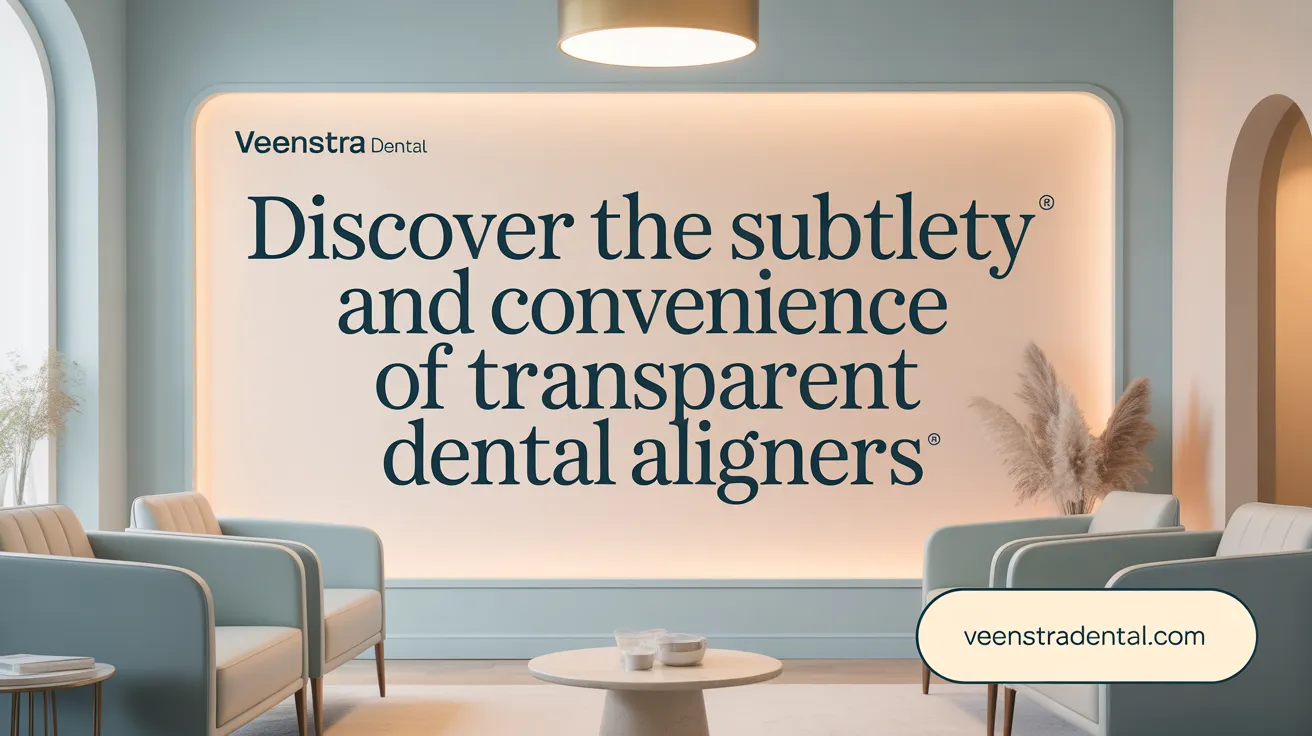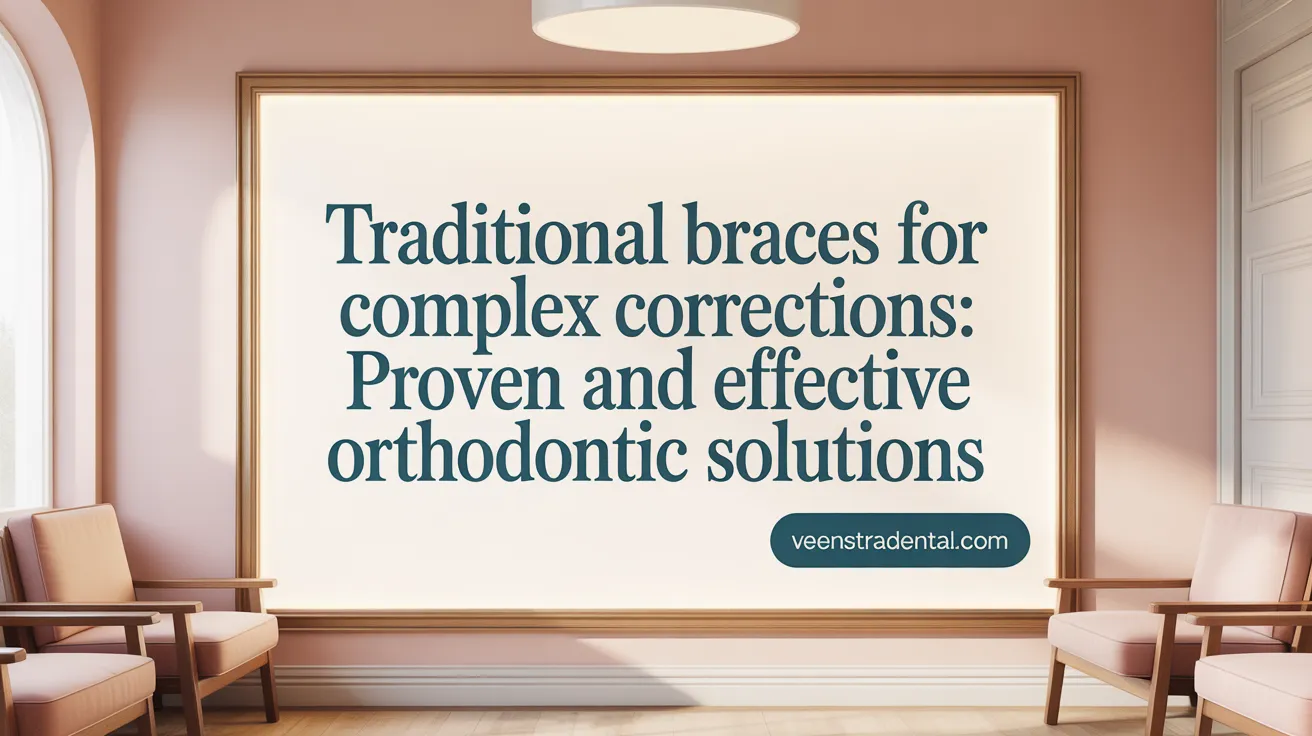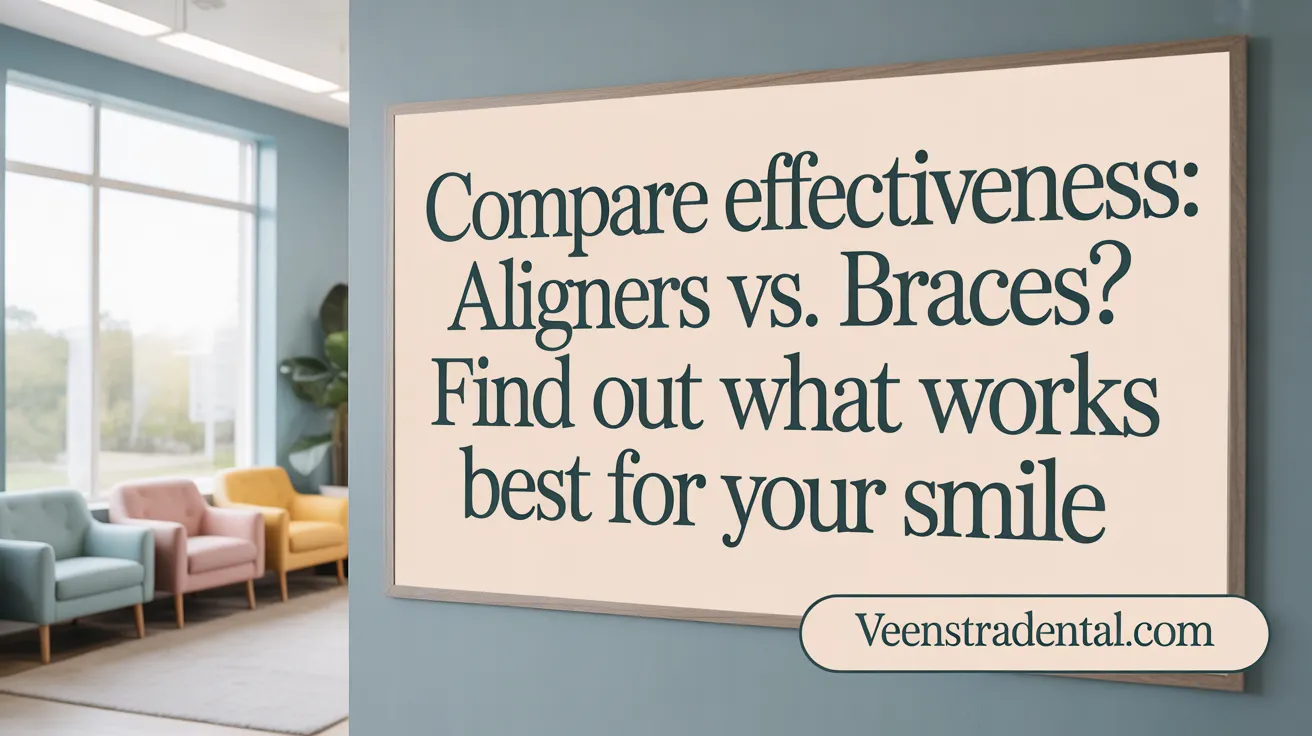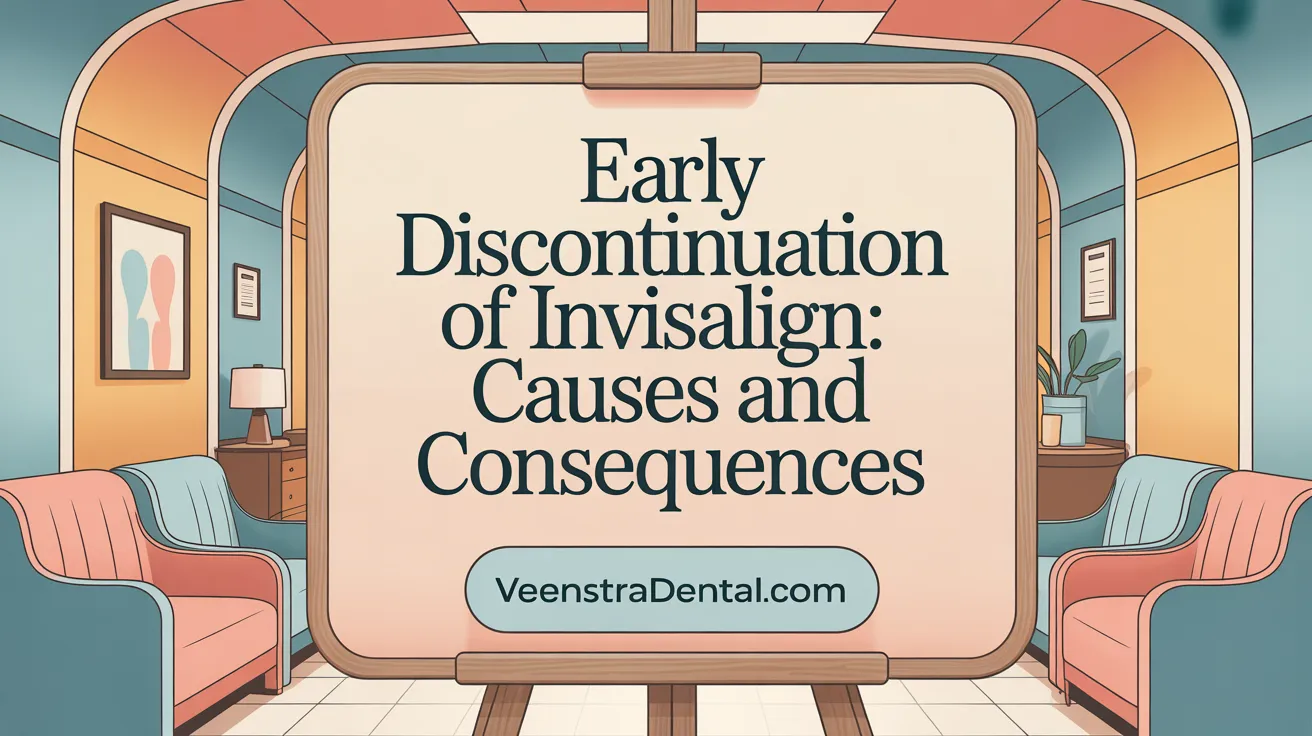Choosing Your Orthodontic Path
Deciding between clear aligners and traditional braces can feel overwhelming given the many factors at play, from aesthetics to effectiveness. Whether you're considering a subtle approach to straighten your teeth or tackling complex dental issues, understanding how each option works, their benefits, and their drawbacks can help you make an informed choice. This article breaks down the differences between clear aligners and braces, focusing on their suitability, treatment experience, and lifestyle impact, empowering you to find the right fit for your smile journey.
Key Facts List about Clear Aligners and Braces
- Clear aligners are made from BPA-free SmartTrack® material that is smooth, transparent, and used in digital 3D design for a precise fit.
- The virtually invisible appearance of clear aligners makes them a discreet option for adults and teens conscious of their smile.
- Clear aligners provide greater comfort and easier oral hygiene, being removable and smoothing mouth ulcers caused by metal braces.
- Traditional braces consist of metal or ceramic brackets with an archwire, effective for complex cases, including severe crowding and bite issues.
- Braces exert continuous pressure and are less dependent on patient compliance, making them ideal for various severe orthodontic problems.
- Clear aligners are effective for mild to moderate issues, often completing treatment in 6-12 months, while braces take 18-24 months for complex cases.
- When comparing effectiveness, aligners suit less complicated issues, but braces outperform for severe and complex corrections.
- Early discontinuation of Invisalign often occurs due to perceived achievement of results, discomfort, treatment duration frustrations, or financial concerns.
- Non-compliance with the required 20-22 hours daily wear can cause delays and incomplete correction with aligners.
- Discontinuing treatment prematurely can lead to suboptimal aesthetic results and may require additional corrective procedures.
1. Subtle and Convenient: The Appeal of Clear Aligners

Material and design
Clear aligners are crafted from BPA-free SmartTrack® material, a smooth, transparent plastic that fits snugly over teeth. They are digitally designed using advanced 3D scanning and imaging technologies, ensuring a precise fit tailored to each individual’s dental structure.
Visibility and aesthetics
One of the major advantages of clear aligners is their virtually invisible appearance. Made from transparent material, these aligners blend seamlessly with natural teeth, making them an appealing option for adults and teens who prefer a discreet treatment. Their subtle presence is ideal for people who are conscious about the appearance of traditional braces.
Comfort and oral hygiene benefits
Unlike traditional braces, which include metal brackets and wires that can cause irritation, clear aligners are smooth and comfortable. They lack sharp edges or protruding components, reducing the likelihood of mouth ulcers and discomfort. Additionally, because aligners are removable, maintaining oral hygiene becomes much easier. Patients can brush and floss normally, leading to less plaque buildup, a lower risk of cavities, and healthier gums during treatment.
Suitability for mild to moderate cases
Clear aligners are especially effective for mild to moderate dental misalignments, such as spacing issues, mild crowding, and simple bite corrections. They may not be suitable for complex cases involving severe crowding or significant bite problems, where traditional braces tend to be more effective.
Treatment duration and patient compliance
Most clear aligner treatments last between six and 18 months, depending on the case complexity. The success of aligner therapy heavily depends on patient compliance, as aligners need to be worn for at least 20-22 hours daily for optimal results. Patients typically switch to a new set of aligners every one to two weeks, gradually moving teeth into their desired positions.
Lifestyle impact and removable nature
One of the biggest appeals of aligners is their removability. Patients can take aligners out during meals, snacks, and special occasions, eliminating dietary restrictions common with braces. They are also convenient for sports and social activities, as they do not interfere with speech or appearance. This versatility makes aligners compatible with active lifestyles.
Technological customization in treatment planning
Aligners are designed using digital scans and 3D imaging, allowing for personalized treatment plans. Orthodontists can predict how teeth will move throughout the treatment, ensuring predictable outcomes. The customization process enhances comfort and efficiency, offering patients a tailored approach with minimal surprises.
Summary of Differences and Similarities
| Feature | Clear Aligners | Traditional Braces | Additional Notes |
|---|---|---|---|
| Material | BPA-free plastic | Metal or ceramic brackets | |
| Visibility | Nearly invisible | Highly visible | |
| Removability | Yes | No | |
| Suitability | Mild to moderate | Complex cases | |
| Typical treatment time | 6-18 months | 18-24 months | |
| Comfort | Higher | Lower | Notable for being smoother |
| Oral hygiene | Easier | Challenging | |
| Cost | Higher upfront | Usually lower |
In conclusion, clear aligners offer a subtle, comfortable, and technologically advanced option for many seeking orthodontic treatment, especially suited for those with mild to moderate dental issues and a preference for a discreet, flexible approach.
2. Traditional Braces: The Trusted Solution for Complex Corrections

Construction and materials of braces
Traditional braces consist of metal or ceramic brackets bonded directly to each tooth. These brackets are connected by an archwire, which applies steady pressure to move teeth into desired positions. The metal brackets are secured with tiny elastic bands, which can be colorful or neutral, adding a customizable aesthetic element. Over recent years, brackets have become smaller and less noticeable, making them more comfortable and less bulky.
Effectiveness for complex and severe cases
Braces are highly effective for correcting a wide range of orthodontic issues, especially severe crowding, rotations, and bite problems. Their design allows orthodontists to exert continuous pressure on teeth, making them suitable for complex dental corrections that may involve significant movement or realignment of the jaw.
Treatment time considerations
The typical duration of treatment with traditional braces ranges from 18 to 24 months, depending on case complexity. More severe orthodontic issues might require longer treatment periods, but braces often produce results more rapidly in such situations compared to aligners. Regular adjustments are scheduled every four to six weeks to tighten wires and continue guiding tooth movement.
Discomfort and oral hygiene challenges
Initially and after adjustments, braces can cause discomfort or soreness. The metal brackets and wires may irritate the inside of the mouth and cause mouth ulcers. Maintaining oral hygiene can be more challenging due to brackets trapping food particles. Special cleaning tools such as interdental brushes and floss threaders are often necessary to prevent plaque buildup and mitigate the risk of cavities.
Visibility and customization options
Traditional braces are inherently more visible than clear aligners, which may influence patient aesthetic preferences. However, options like ceramic brackets and colored bands provide opportunities for personalization, especially among teenagers. Despite their visibility, braces can be customized for comfort and appearance, with some patients opting for less conspicuous ceramic or lingual brackets placed on the inside of teeth.
Dependability without patient compliance
One of the main advantages of braces is that they do not depend on patient discipline to work. Once installed, they exert continuous force and progress toward alignment without requiring removal or daily commitment. This makes them particularly suitable for patients who may struggle with compliance or for those with complex orthodontic needs.
Cost aspects and accessibility
Traditional braces tend to have a lower initial cost compared to clear aligners. They are widely accessible and have been used successfully for decades, making them an affordable option for many patients. Financial plans and insurance coverage often support orthodontic treatment with braces, facilitating access for a broad demographic.
Why braces remain a preferred choice for difficult orthodontic issues
Despite the rise of clear aligners, braces continue to be the preferred solution for complex or severe dental problems. Their proven track record, ability to address significant crowding, rotations, and bite issues, and adaptability to various cases ensure they remain at the forefront of orthodontic treatments for challenging corrections.
Effectiveness Comparison: Clear Aligners vs. Traditional Braces

Are clear aligners as effective as traditional braces for orthodontic treatment?
Both clear aligners and traditional braces are proven to be effective tools for correcting various dental misalignments. Generally, they work well for mild to moderate issues such as crowding, gaps, and bite corrections.
Clear aligners, like Invisalign®, are smooth, transparent, and removable plastic trays. They are designed based on digital scans, gradually shifting teeth into proper positions. Their advantages include being nearly invisible, which makes them especially popular among adults and teens who prefer subtlety. They typically take about 6 to 12 months to complete for simple cases, and require the patient to wear them for at least 20-22 hours daily.
Traditional braces involve metal or ceramic brackets bonded directly to teeth, connected by wires that are adjusted periodically. They exert continuous pressure to move teeth and are highly effective for more complex orthodontic challenges. While they usually take about 18 to 24 months, they are capable of correcting severe issues like severe crowding, rotations, and complex bite problems.
In summary, for less complicated cases, clear aligners can be just as effective as metal braces. They offer benefits such as comfort and convenience, with fewer visits needed for adjustments. However, for complex dental issues requiring extensive tooth movement, traditional braces often outperform aligners in efficiency and outcomes.
Choosing the right treatment depends on the specific dental issues, patient lifestyle, and preferences. Consulting with an orthodontist helps determine whether clear aligners are a suitable option or if traditional braces are necessary for more complex corrections.
Understanding Early Discontinuation of Invisalign Treatment

What are the common reasons people discontinue Invisalign treatment early?
Many patients decide to stop their Invisalign therapy before completing the full course. Common motivations include feeling that their teeth have achieved the desired appearance, leading them to believe no further treatment is necessary. Others may experience discomfort or pain that becomes difficult to tolerate, especially during initial days of wearing a new aligner.
Some individuals lose patience with the length of treatment, which typically lasts between 6 to 18 months depending on the case. If the results seem slower than expected or if expectations are not met, patients might feel dissatisfied and choose to discontinue early. Financial factors also play a role; after paying for the treatment, some might opt to stop rather than invest in additional aligners, especially if they face unexpected expenses.
Compliance issues are significant contributors to early treatment termination. Invisalign requires wearing the aligners for 20 to 22 hours daily, and failure to adhere can cause delays, discomfort, and frustration. When patients encounter these challenges, they might decide to halt their treatment altogether.
Although patients hold the right to end treatment at any moment, early discontinuation often results in incomplete correction. This can lead to less optimal aesthetic results and limited advancements in dental health, potentially necessitating further corrective procedures in the future.
Making Your Choice: What Fits Your Smile and Lifestyle?
Choosing between clear aligners and traditional braces ultimately depends on your unique dental needs, lifestyle preferences, and treatment goals. Clear aligners offer a discreet, comfortable, and flexible way to correct mild to moderate orthodontic issues, appealing especially to adults and teens who value subtlety and convenience. Traditional braces remain a reliable and effective choice for more complex or severe cases, with the advantage of continuous appliance wear that doesn't rely on patient compliance. Consulting with an orthodontic professional will help tailor the best treatment plan to your situation, ensuring a confident smile transformation that fits your life and expectations.
References
- Clear Aligners vs. Braces: Deciding Your Best Orthodontic Option
- Clear Aligners vs Traditional Braces – Which Is Right for You?
- Invisalign vs. Braces: Which Is Right for You? - Redwood City Dentistry
- Clear Aligners vs Metal Braces: What Matches Your Lifestyle?
- Invisalign vs. Traditional Braces: Comparing Aesthetics and ...
- 7 Advantages of Choosing Clear Aligners Over Traditional Braces
- Clear Aligners vs. Traditional Braces: Which Is Right for You?
